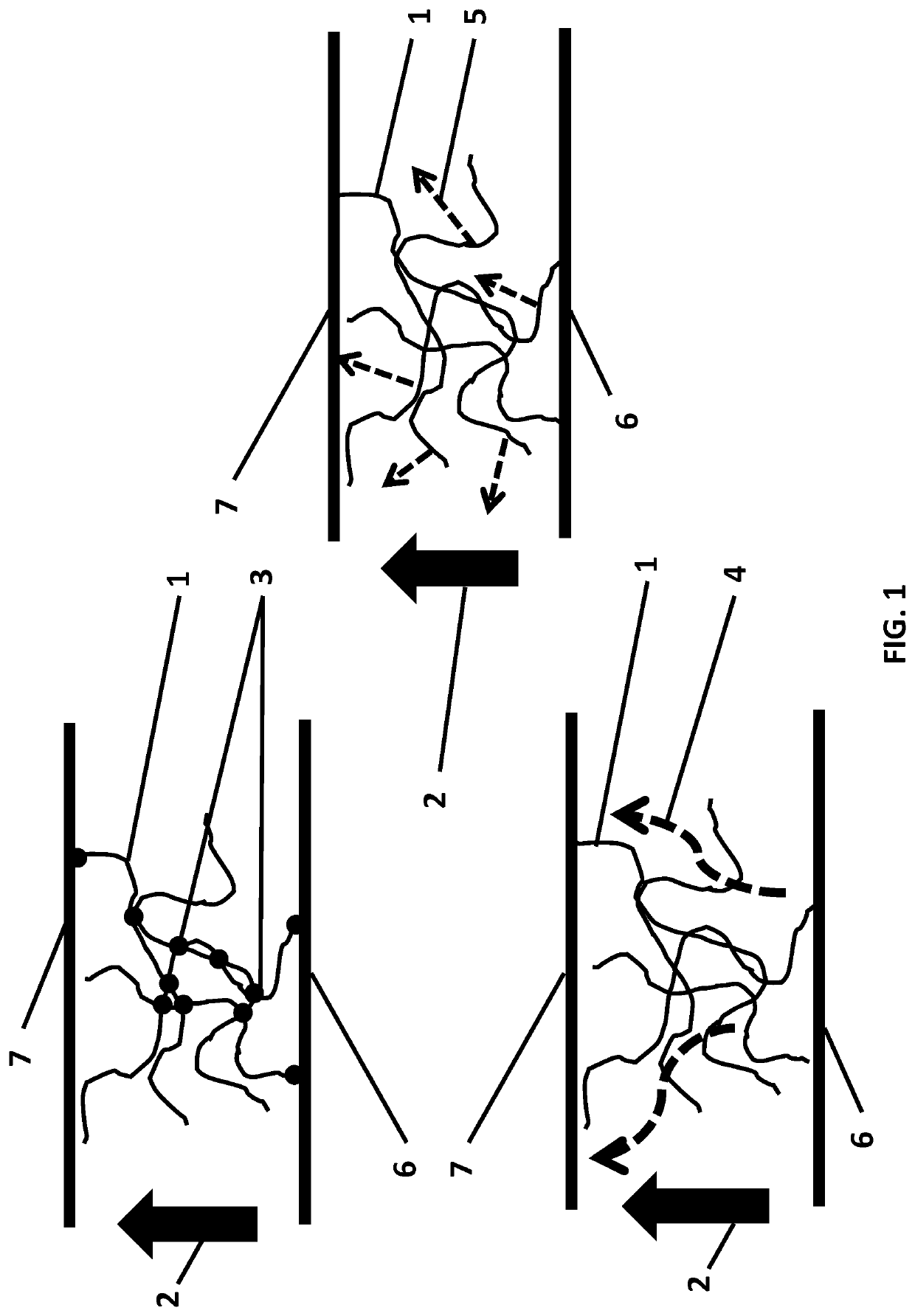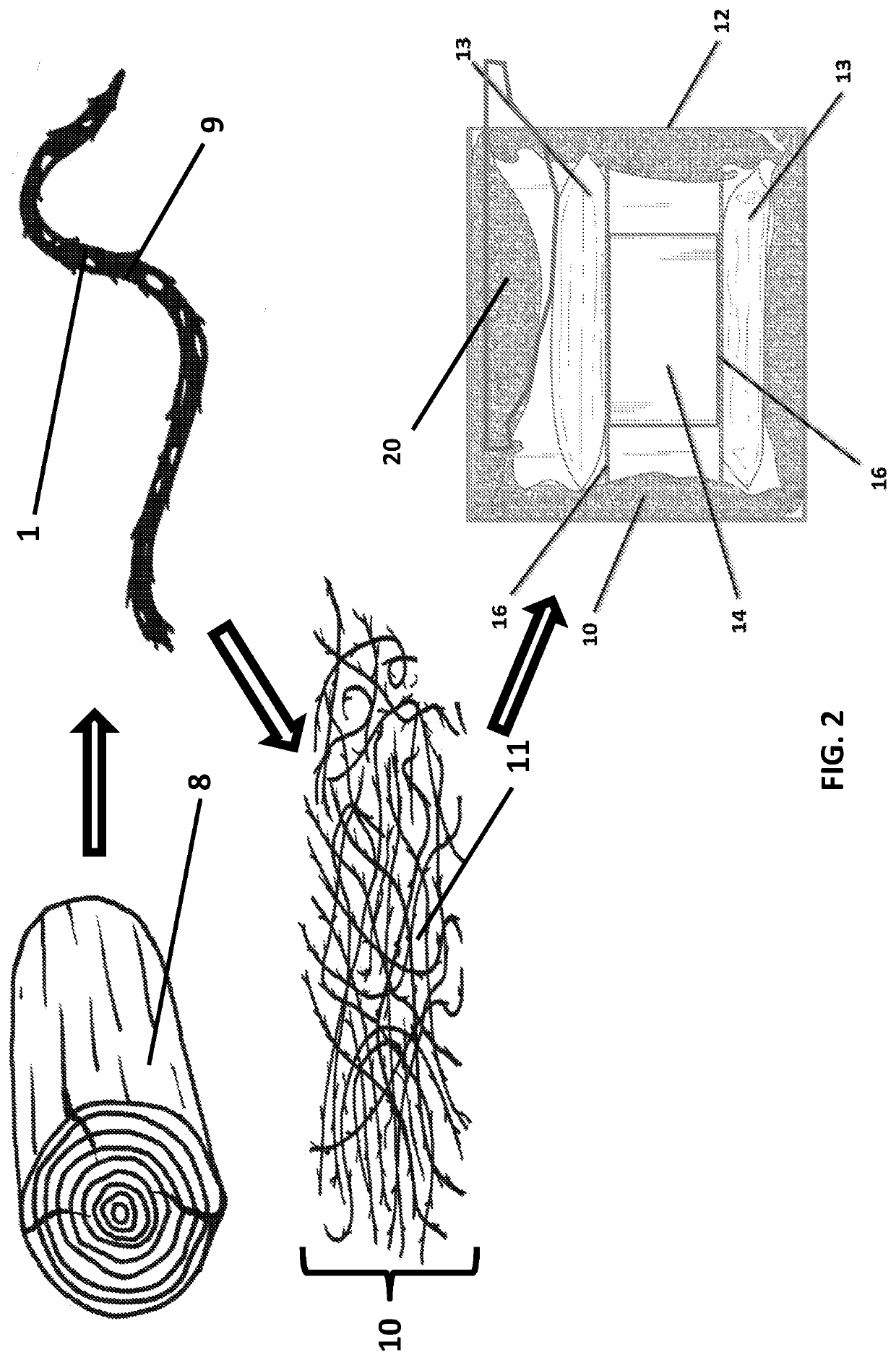Biotic material apparatus for thermally protecting and/or transporting temperature sensitive products
a technology of thermal protection and/or temperature-sensitive products, applied in the direction of domestic cooling devices, lighting and heating devices, transportation and packaging, etc., to achieve the effect of reducing handling difficulties and shipping costs, efficient utilization of storage space, and low cos
- Summary
- Abstract
- Description
- Claims
- Application Information
AI Technical Summary
Benefits of technology
Problems solved by technology
Method used
Image
Examples
example 1
[0047]As an example, a BMIM composed of woody filaments (a woody biotic filament insulation medium), where 80% of the woody filaments ≥3.0 inches (0.076 in) long, with woody filament cross-sectional dimensions of 0.018″±0.003″×0.038″±0.008″ (0.46 mm±0.08 mm×0.97 mm±0.20 mm), with a woody filament moisture content in the range of 9-14%, 15-29%, 16-28%, 17-27%, 18-26%, 19-25%, 20-24%, 21-23%, and / or approximately 20%, can be arranged in a way to achieve a biotic material insulation medium having dimensions of 11″×29″×1″ (280 mm×740 mm×25.4 mm) with a total weight of 0.55 lbs (0.25 kg), when air is filling the voids between the filaments. This total weight (mass) of the BMIM includes the weight (mass) of the filaments and the weight (mass) of the air filling the voids between the filaments (noting that one cannot weigh the filaments “by themselves” unless weighing the filaments in a vacuum). The apparent bulk density of such a biotic material insulation medium is 0.00172 lb / in3 (48 kg / ...
example 2
[0048]This example, similar to the embodiment shown in FIG. 3, relates to an insulating packaging container assembly that includes a corrugated box of 9″×11″×12″ with two insulation pads, incorporating the biotic material insulation medium described in Example 1, positioned Within the box such that each insulation pad is placed in a U shape configuration and the two frozen gel packs (26 ounces each) are placed in the enclosed volume, as well as a payload of 20 ml (two 10-ounce vials). The goal of placing this payload in the enclosed volume of this package is to maintain the product (payload) in a thermal environment having a temperature in a range of 2-8.5° C. for 36 hours during a summer shipment, where a summer shipment may result in the insulating packaging container assembly being exposed to environmental temperatures (i.e., surrounding temperatures the assembly is positioned in) of ≥75° F., ≥80° F., ≥85° F., and / or ≥90° F., for the entire 36 hours. In specific embodiments, such...
example 3
[0063]Using the same woody biotic filament insulation medium presented in Example 2, i.e., Pad #1 in table 1, it is possible to calculate the effective thermal conductivity of the biotic filament insulation medium.
[0064]The apparent porosity (AP) can be calculated via AP=(Ps−Pbm) / (Ps−Po), where[0065]Ps=420 kg / m3 [0066]Po=1.2 kg / m3 [0067]Pbm=48 kg / m3 [0068]such that AP=(420−48) / (420−1.2)=0.887
and the effective thermal conductivity of the biotic filament insulation medium (kbm) can be calculated via ks / kbm=1−AP1 / 3+AP1 / 3 ((ko / ks) AP2 / 3+1−AP2 / 3), where[0069]ks=0.09 W / m-K[0070]ko=0.025 W / m-K[0071]such that ks / kbm=1−0.961+0.961 / 0.3336=2.919[0072]kbm=0.09 w / m-k / 2.919=0.0308 W / m-K
[0073]Due to the nature of the biotic filament insulation medium, the thermal properties of the biotic filament insulation medium can be described using a property that takes into account the type(s) of biotic filament(s) used, the type of gas in the voids between biotic filaments, as well as the global moisture co...
PUM
| Property | Measurement | Unit |
|---|---|---|
| bulk density | aaaaa | aaaaa |
| density | aaaaa | aaaaa |
| porosity | aaaaa | aaaaa |
Abstract
Description
Claims
Application Information
 Login to View More
Login to View More - R&D
- Intellectual Property
- Life Sciences
- Materials
- Tech Scout
- Unparalleled Data Quality
- Higher Quality Content
- 60% Fewer Hallucinations
Browse by: Latest US Patents, China's latest patents, Technical Efficacy Thesaurus, Application Domain, Technology Topic, Popular Technical Reports.
© 2025 PatSnap. All rights reserved.Legal|Privacy policy|Modern Slavery Act Transparency Statement|Sitemap|About US| Contact US: help@patsnap.com



